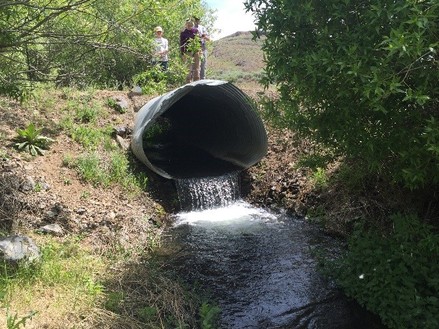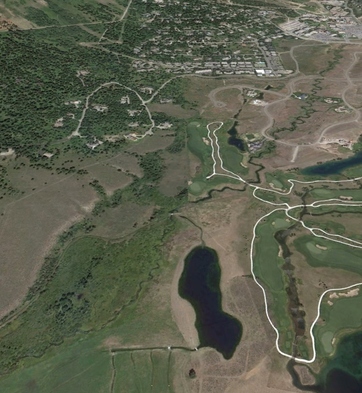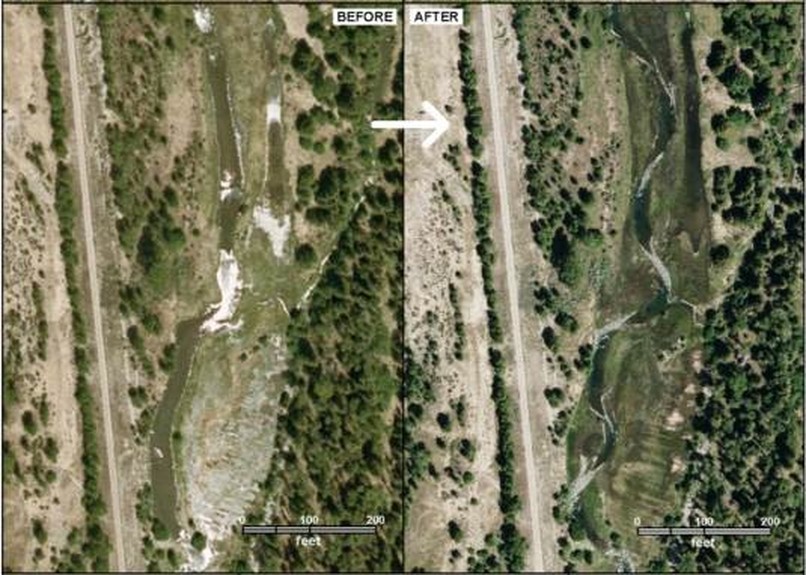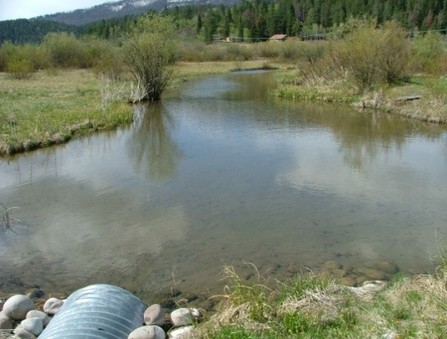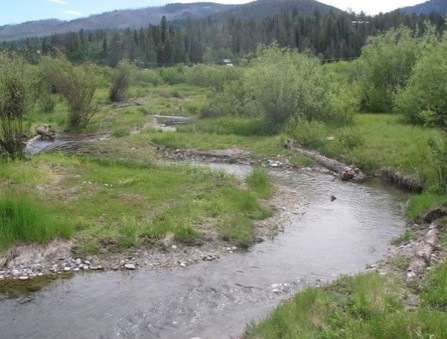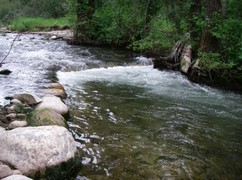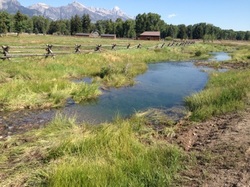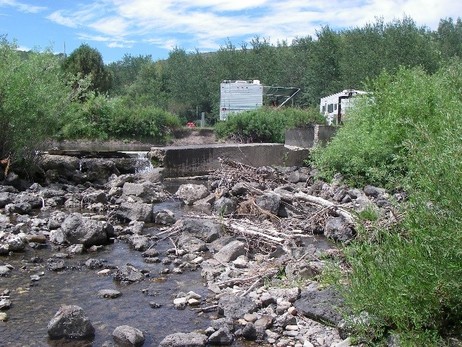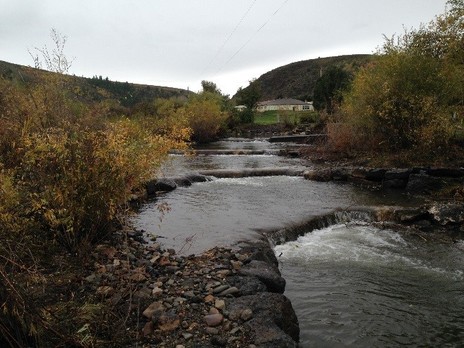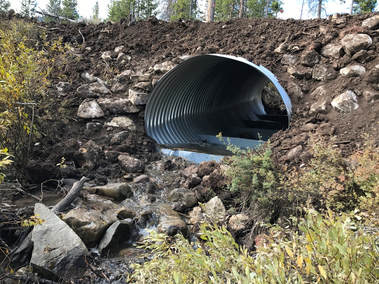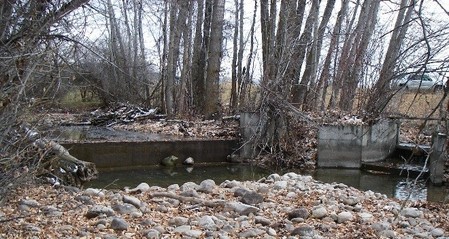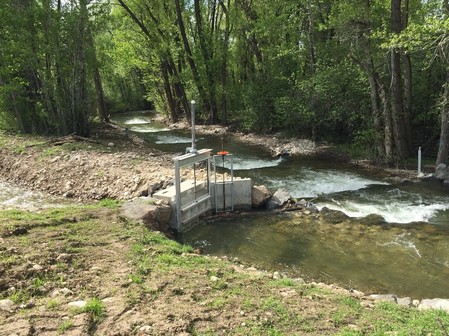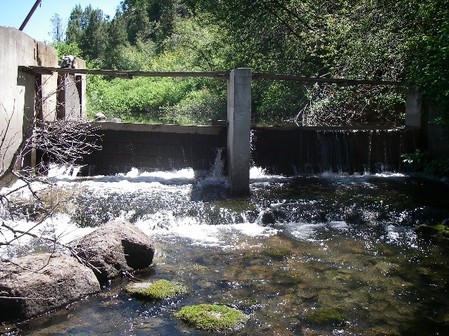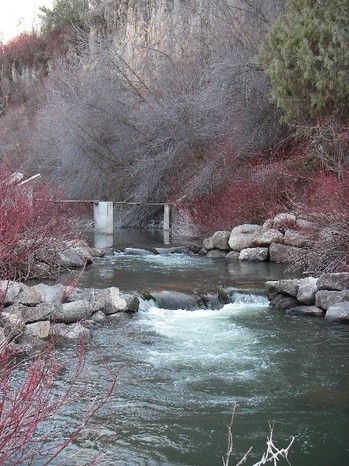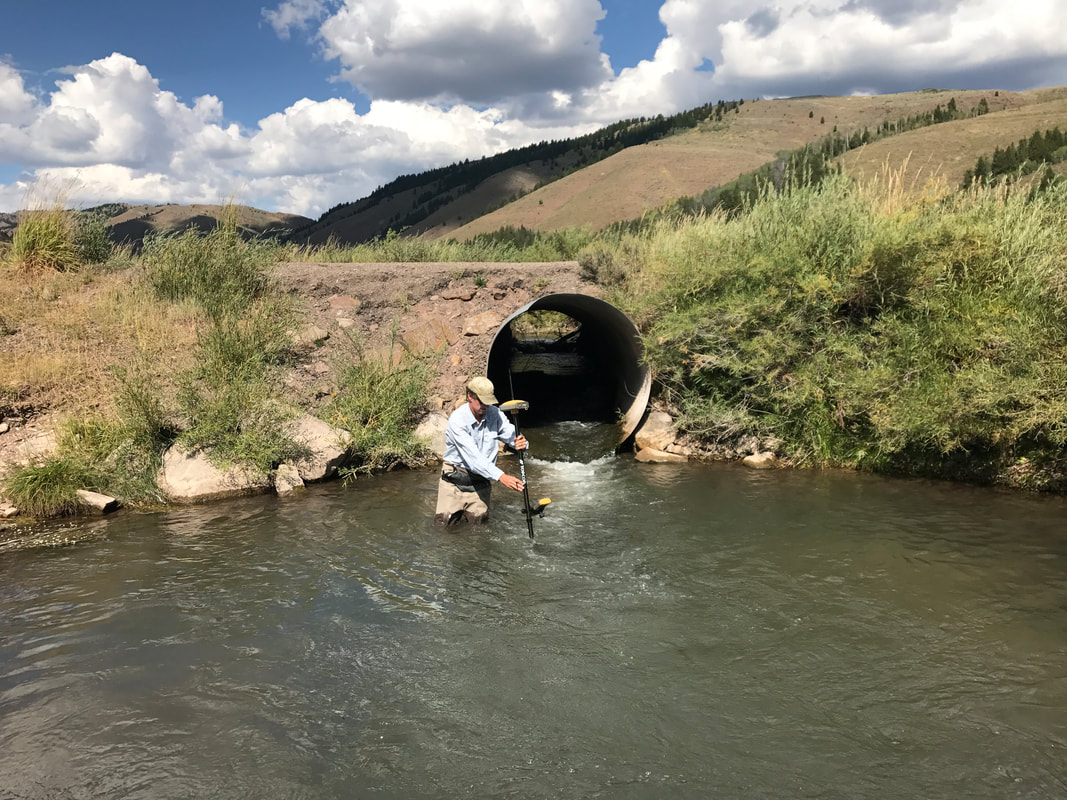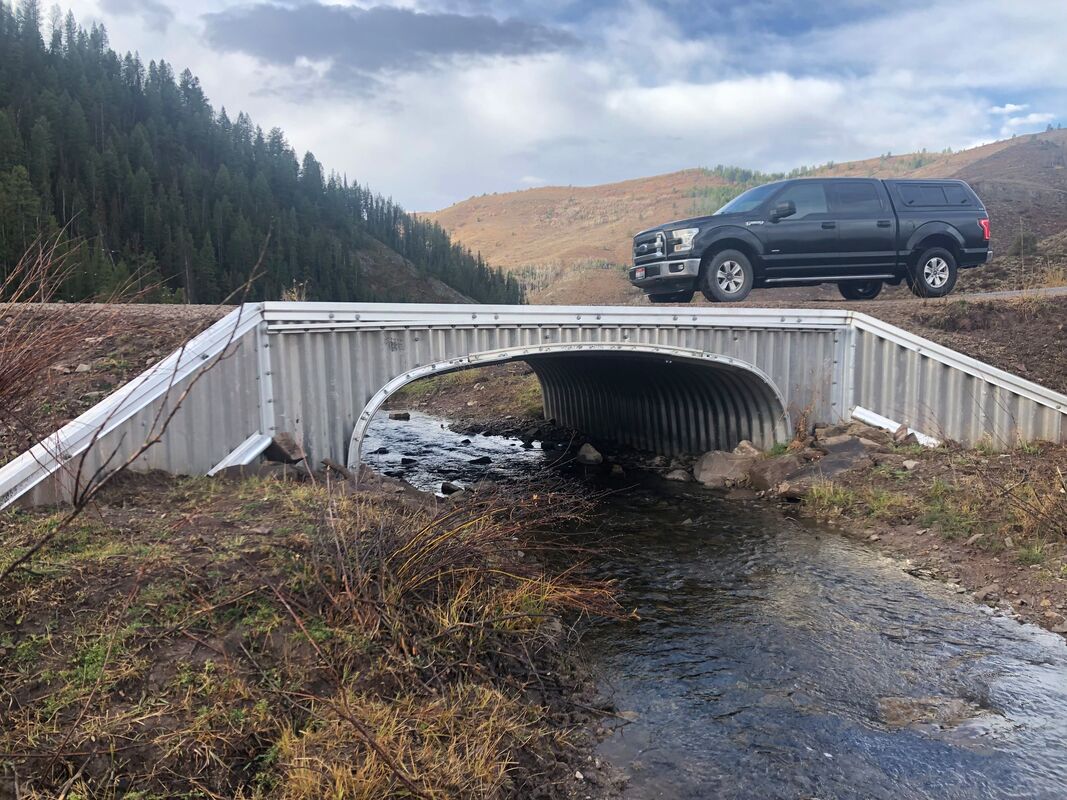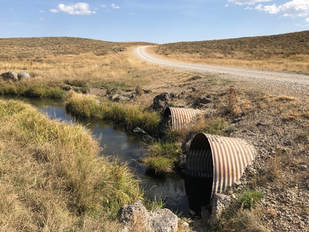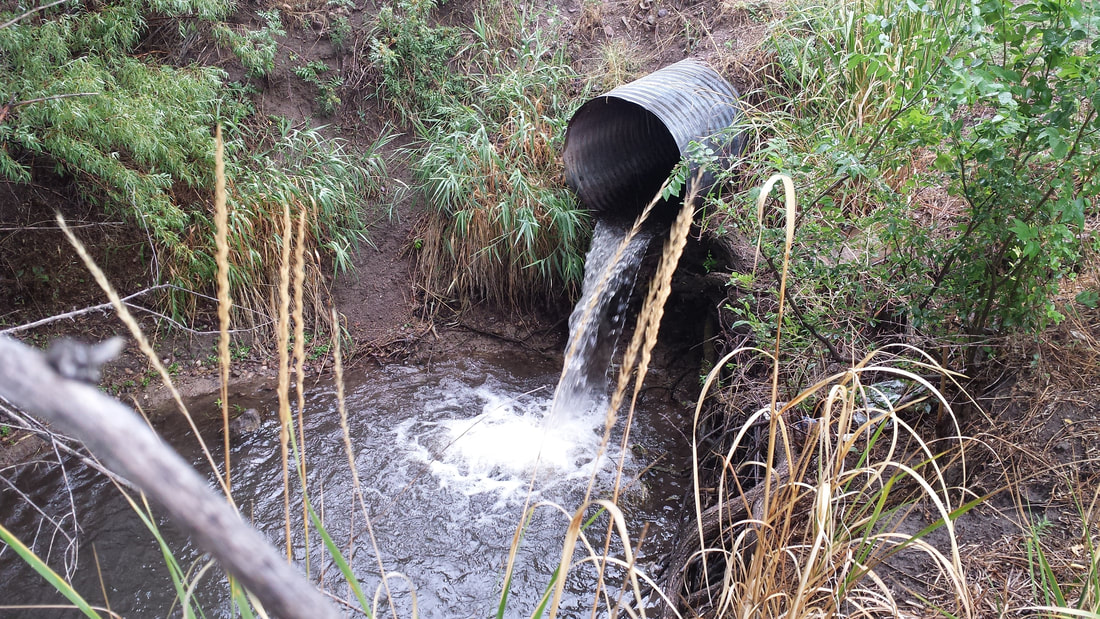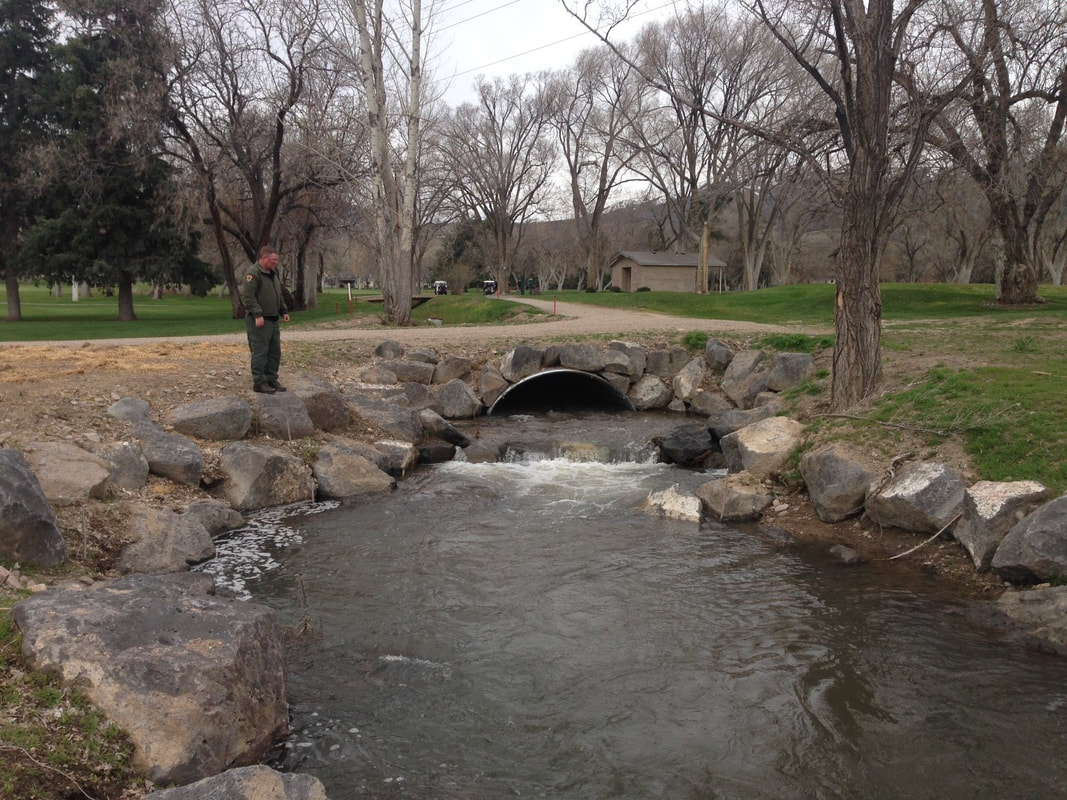Fisheries Projects
|
Rock Creek Ranch Restoration Project, Blaine County, Idaho
Biota was hired through a collaborative group comprised of The Nature Conservancy, Wood River Land Trust, and Trout Unlimited to refine, finalize, permit, and implement large-scale stream restoration and fish passage improvement treatments on a 10,000 acre property in Blaine County, Idaho, that is prioritized for public benefit and ecological restoration values. Biota was tasked with designing, securing regulatory approval for, and constructing landscape-level treatments to rectify channel disconnections, fish passage barriers, and systemic fluvial impairments. The ongoing project includes active stream restoration efforts pursued by diverse conservation organizations to improve ecological, aquatic, and public values on an active agricultural property located in central Idaho. |
|
Fish Creek Habitat Enhancement Project - Jackson, Wyoming
This project grew from a sub-reach assessment effort to a phased fluvial enhancement project spanning dozens of parcels with different ownership in the headwaters of Fish Creek. Due to altered hydrologic regime resulting from local land uses and irrigation practices, the morphology of upper Fish Creek was in disequilibrium when compared to existing flow regime and sediment inputs. The resultant hydraulic conditions limited fish habitat for native Snake River cutthroat trout, and resulted in degraded fluvial processes. A Natural Channel Design approach was used to design stable channel form through a 2-mile reach of Fish Creek. The project design was implemented in 2014 and 2015 with partial funding provided by the Teton Conservation District and with the support of the Wyoming Game and Fish Department. The next phase of the project is scheduled for implementation in 2016. Restoration treatments were designed to maximize aquatic habitat for native cutthroat trout, and included modification of channel dimension, pattern, and profile to achieve appropriate hydraulic conditions under the current hydrologic regime, sediment conditions, and land uses. |
Price Spring Creek Fisheries Enhancement and Channel Restoration Project - Jackson, Wyoming
The Price Spring Creek Restoration Project involved restoring a dredged and straightened creek system that was degraded as the result of past manipulations and flood prevention measures. A Natural Channel Design approach was used to identify channel dimension, pattern, and profile through the 2-mile long project reach that encompassed a dozen separate landowners. Restoration efforts were accomplished through channel realignment and reconstruction of functional channel morphology. Instream structures were not deemed necessary; channel construction was accomplished through placement of appropriately sized substrate to construct design profile, and transplants of woody and herbaceous vegetation to construct geometry. Treatments included construction of spawning, rearing, over-wintering, refuge, feeding, and improved passage (through culvert modification) for native Snake River fine-spotted cutthroat trout. The project resulted in an increase in spawning activities from fewer than 6 pairs pre-construction in 2006, 2007, and 2008 to more than 60 pairs post-construction in both 2009 and 2010.
The Price Spring Creek Restoration Project involved restoring a dredged and straightened creek system that was degraded as the result of past manipulations and flood prevention measures. A Natural Channel Design approach was used to identify channel dimension, pattern, and profile through the 2-mile long project reach that encompassed a dozen separate landowners. Restoration efforts were accomplished through channel realignment and reconstruction of functional channel morphology. Instream structures were not deemed necessary; channel construction was accomplished through placement of appropriately sized substrate to construct design profile, and transplants of woody and herbaceous vegetation to construct geometry. Treatments included construction of spawning, rearing, over-wintering, refuge, feeding, and improved passage (through culvert modification) for native Snake River fine-spotted cutthroat trout. The project resulted in an increase in spawning activities from fewer than 6 pairs pre-construction in 2006, 2007, and 2008 to more than 60 pairs post-construction in both 2009 and 2010.
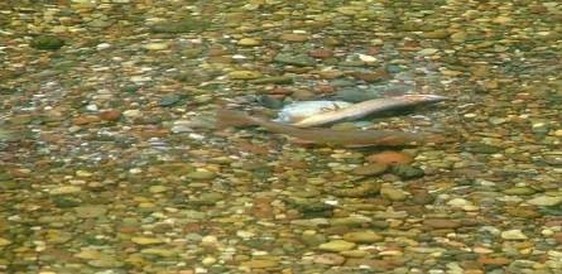
3 Channel Spring Creek Restoration Project, Teton County, Wyoming
The 3 Channel Spring Creek Restoration Project involved spring creek restoration activities and fish habitat enhancement throughout the 2-mile project area reach. The project was implemented in collaboration/cooperation with private landowners, Wyoming Game and Fish, and Jackson Hole Trout Unlimited.
A Natural Channel Design approach involving empirical and analytical design techniques was used to design stable channel morphology based on hydrologic regime and sediment load. The project involved restoring channel dimension, pattern, and profile while improving floodplain connectivity and hydrologic support for riparian vegetation. Within the natural channel design framework, morphological features and specific habitat conditions were created to maximize year-round and spawning habitat for native cutthroat trout. The effort resulted in a nearly 300% increase in spawning activities of native cutthroat trout, and the area is now an important nursery and recruitment area for the regional Snake River cutthroat trout population. Due to the success of this project, multiple adjacent and proximate landowners initiated similar stream restoration actions in the years following implementation.
The 3 Channel Spring Creek Restoration Project involved spring creek restoration activities and fish habitat enhancement throughout the 2-mile project area reach. The project was implemented in collaboration/cooperation with private landowners, Wyoming Game and Fish, and Jackson Hole Trout Unlimited.
A Natural Channel Design approach involving empirical and analytical design techniques was used to design stable channel morphology based on hydrologic regime and sediment load. The project involved restoring channel dimension, pattern, and profile while improving floodplain connectivity and hydrologic support for riparian vegetation. Within the natural channel design framework, morphological features and specific habitat conditions were created to maximize year-round and spawning habitat for native cutthroat trout. The effort resulted in a nearly 300% increase in spawning activities of native cutthroat trout, and the area is now an important nursery and recruitment area for the regional Snake River cutthroat trout population. Due to the success of this project, multiple adjacent and proximate landowners initiated similar stream restoration actions in the years following implementation.
Fish Creek Tributary Habitat Enhancement Project - Wilson, Wyoming
This project involved application of Natural Channel Design techniques to reconstruct stable channel morphology, floodplain, and aquatic habitat in a thousand-foot reach of an unnamed spring creek tributary to Fish Creek. An existing culvert crossing of the channel was removed, and high quality fish habitat features were established. Abundant silt deposits were removed, clean gravel substrate was installed, and a functional channel morphology was constructed.
The restored spring creek system is characterized as a meandering pool-riffle bed feature channel that provides high quality year-round habitat for all age-classes of native Snake River cutthroat trout. Post-construction project monitoring documented a significant increase in utilization of the reach by adult and juvenile Snake River cutthroat trout--during the first year after project implementation.
This project involved application of Natural Channel Design techniques to reconstruct stable channel morphology, floodplain, and aquatic habitat in a thousand-foot reach of an unnamed spring creek tributary to Fish Creek. An existing culvert crossing of the channel was removed, and high quality fish habitat features were established. Abundant silt deposits were removed, clean gravel substrate was installed, and a functional channel morphology was constructed.
The restored spring creek system is characterized as a meandering pool-riffle bed feature channel that provides high quality year-round habitat for all age-classes of native Snake River cutthroat trout. Post-construction project monitoring documented a significant increase in utilization of the reach by adult and juvenile Snake River cutthroat trout--during the first year after project implementation.
|
South Leigh Creek Restoration Project, Teton County, Idaho
The South Leigh Creek Restoration Project involved implementation of stream channel restoration and aquatic habitat improvements within a 1.5 mile reach of the flashy Teton River tributary located on the west side of the Teton Mountain Range. The restoration design was developed based on local hydrologic regime, geomorphic assessment, and sediment transport investigations. Restoration efforts were specifically developed to address the life history requirements of native Yellowstone cutthroat trout, and post-project implementation documented a dramatic increase in utilization of the reach by native cutthroat trout. Fleischman's Creek Habitat Enhancement, East Bank Snake River, Teton County, Wyoming
This project included the removal of a 3-foot barrier to fish passage, and the subsequent reconstruction of stable channel morphology within an 2,000-foot reach of a spring creek tributary to the Snake River. A Natural Channel Design approach was applied to define stable channel morphology based upon hydrologic regime, sediment inputs, and boundary conditions. This effort involved aquatic habitat enhancement activities designed to benefit all size-classes of native cutthroat trout within a spring creek channel located on the east bank of the Snake River. The project was immediately successful in increasing aquatic habitat--including spawning, rearing, over-winter, cover, and feeding conditions for native cutthroat trout. |
|
Fish Passage
Canyon Creek Fish Passage Restoration - Eastern Idaho
Biota completed site assessment, design, permitting, and implementation of this fish passage restoration project. The upper Canyon Creek diversion, which supplies irrigation water to numerous downstream agricultural operations, included a channel-spanning concrete sill designed to maintain necessary hydraulic head at the point of diversion. The concrete sill, and widespread rock riprap placed immediately downstream, maintained a barrier to upstream fish passage during most flow rates.
Biota generated a system solution that enabled the concrete sill to remain intact, which ensured water users that the effort would not alter surface water availability or diversion operations.
Immediately downstream of the sill, a series of permanent rock grade control structures were installed in order to distribute local gradient between distinct features that the target age classes of wild Yellowstone cutthroat trout could navigate. In-stream treatments were designed to transport the available sediment load, maintain floodplain connectivity (at the bankfull discharge), and achieve stable channel form under the local hydrologic regime.
Biota completed site assessment, design, permitting, and implementation of this fish passage restoration project. The upper Canyon Creek diversion, which supplies irrigation water to numerous downstream agricultural operations, included a channel-spanning concrete sill designed to maintain necessary hydraulic head at the point of diversion. The concrete sill, and widespread rock riprap placed immediately downstream, maintained a barrier to upstream fish passage during most flow rates.
Biota generated a system solution that enabled the concrete sill to remain intact, which ensured water users that the effort would not alter surface water availability or diversion operations.
Immediately downstream of the sill, a series of permanent rock grade control structures were installed in order to distribute local gradient between distinct features that the target age classes of wild Yellowstone cutthroat trout could navigate. In-stream treatments were designed to transport the available sediment load, maintain floodplain connectivity (at the bankfull discharge), and achieve stable channel form under the local hydrologic regime.
|
Upper Gros Ventre River Tributary Restoration and Fish Passage Project - Teton County, Wyoming
Biota was contracted by Trout Unlimited and the Trust for PublicLand (in collaboration with the Bridger Teton National Forest and the Wyoming Game and Fish Department) to complete site assessment, design, permitting, and construction supervision of this large-scale watershed restoration project. The effort included restoration of habitat and fish passage within 6 tributaries to the upper Gros Ventre River that had been impactedby homestead activities over 100 years ago. Specific project components included reestablishment of stream channel with design morphology in order to convey tributary water to the mainstem while promoting fish passage, providing fish habitat for various life stages of cutthroat trout, restoring sediment transport, and improving riparian conditions. A total of 5 over-sized metal culverts were sized and designed to include metal baffles to retain native alluvium to simulate live stream bottom conditions. The culverts were installed at 5 distinct Forest Service road crossings of tributaries, and functioned to restore hydrologic connectivity and fish passage within the basin. |
Desert Canal Fish Passage and Channel Restoration Project - Teton County, Idaho
The Desert Canal Diversion provides surface water to 40 agricultural users, and the facility included a channel spanning concrete sill that presented a barrier to upstream fish movement and severely altered the local sediment transport regime and ecological functions of the watercourse.
The project involved complete removal of the concrete sill, reconstruction of the diversion facility, installation of a sediment sluice gate in the diversion bay to prevent deposition, and a series of rock grade control structures to maintain grade and distribute gradient between small cascades that could be navigated by target size classes of Yellowstone cutthroat trout during upstream or downstream movement.
The project was implemented in 2014 with funding provided by the US Fish and Wildlife Service through the Native Fish Passage Program, the local chapter of Trout Unlimited through an Embrace A Stream grant, the local non-profit Friends of the Teton River, and private landowners.
The Desert Canal Diversion provides surface water to 40 agricultural users, and the facility included a channel spanning concrete sill that presented a barrier to upstream fish movement and severely altered the local sediment transport regime and ecological functions of the watercourse.
The project involved complete removal of the concrete sill, reconstruction of the diversion facility, installation of a sediment sluice gate in the diversion bay to prevent deposition, and a series of rock grade control structures to maintain grade and distribute gradient between small cascades that could be navigated by target size classes of Yellowstone cutthroat trout during upstream or downstream movement.
The project was implemented in 2014 with funding provided by the US Fish and Wildlife Service through the Native Fish Passage Program, the local chapter of Trout Unlimited through an Embrace A Stream grant, the local non-profit Friends of the Teton River, and private landowners.
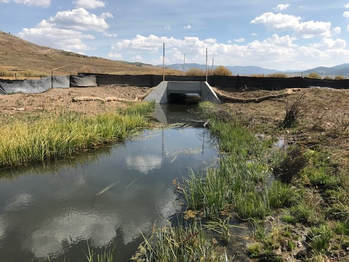
Angus Creek Fish Passage Project, Caribou County, Idaho
Biota worked for Trout Unlimited to engineer and design a project to improve fish passage for native Bonneville cutthroat trout through 2 county roadway crossings of Angus Creek in the Upper Blackfoot River drainage. Implementation of the project involved installation of fabricated concrete box culverts with live bottom stream conditions, and fluvial system site improvements that achieved fish passage objectives, protected public infrastructure and access.
Biota worked for Trout Unlimited to engineer and design a project to improve fish passage for native Bonneville cutthroat trout through 2 county roadway crossings of Angus Creek in the Upper Blackfoot River drainage. Implementation of the project involved installation of fabricated concrete box culverts with live bottom stream conditions, and fluvial system site improvements that achieved fish passage objectives, protected public infrastructure and access.
Canyon Creek Pump Station Fish Passage Project - Eastern Idaho
Biota completed assessment, design, and implementation of fish passage projects at 2 pump stations on lower Canyon Creek. Both pump stations consisted of channel-spanning concrete structures that enabled seasonal installation of impoundments to increase local stage (by 4 or 5 feet) to prevent pump cavitation. The impoundments and associated splash pads precluded the upstream movement of wild Yellowstone cutthroat trout in this important spawning tributary. The facilities also precluded the downstream movement of fish and stranded all size classes in the backwatered upstream intake bays.
Biota designed and implemented system solutions that included fabrication and installation of a permanent bottom impoundment board, which was constructed of steel and included a small manually operated slide gate. Permanent rock cross vanes were then installed downstream of each facility. The in-stream treatments maintained a slight backwater over the splash pads (to inundate the small slide gate), and distributed local gradient between individual cascades that could be navigated by the wild fishery during upstream or downstream movement. When the small slide gates are open, bypass flows are consolidated through the slide gate and all age classes of the target species can move upstream or downstream, and the configuration does not impede pump station operations.
Biota completed assessment, design, and implementation of fish passage projects at 2 pump stations on lower Canyon Creek. Both pump stations consisted of channel-spanning concrete structures that enabled seasonal installation of impoundments to increase local stage (by 4 or 5 feet) to prevent pump cavitation. The impoundments and associated splash pads precluded the upstream movement of wild Yellowstone cutthroat trout in this important spawning tributary. The facilities also precluded the downstream movement of fish and stranded all size classes in the backwatered upstream intake bays.
Biota designed and implemented system solutions that included fabrication and installation of a permanent bottom impoundment board, which was constructed of steel and included a small manually operated slide gate. Permanent rock cross vanes were then installed downstream of each facility. The in-stream treatments maintained a slight backwater over the splash pads (to inundate the small slide gate), and distributed local gradient between individual cascades that could be navigated by the wild fishery during upstream or downstream movement. When the small slide gates are open, bypass flows are consolidated through the slide gate and all age classes of the target species can move upstream or downstream, and the configuration does not impede pump station operations.
Salt Creek Fish Passage Project, Lincoln County, Wyoming
Biota was contracted by a collaborative group that included Trout Unlimited, Wyoming Game and Fish Department, and US Forest Service to complete an assessment and develop a fish passage and stream restoration design plan for 3 miles of Salt Creek in the Thomas Fork drainage. Biota completed hydrologic investigations, a geomorphic assessment, application of Natural Channel Design techniques, a sediment transport analysis, and FishXing modeling to design restoration treatments and an improved USFS road crossing of Salt Creek. The project replaced a perched corrugated metal pipe culvert with an aluminum box culvert to restore fish passage into the upper watershed.
The final design incorporated a primary crossing structure that enabled conveyance of the 50-year recurrence interval flow while providing fish passage for native cutthroat trout. Floodplain conveyance culverts were then incorporated within the design to enable the conveyance of the 100-year flood through the reach while maintaining fish passage even during base flood conditions. This final design also included bioengineered bank stabilization treatments throughout the 11,200 ft project reach. Design treatments in the vicinity of the USFS road crossing included establishment of stable channel dimension, pattern, and profile to be achieved using natural materials including log structures, willow clumps, herbaceous vegetation mats, and native alluvium.
Biota was contracted by a collaborative group that included Trout Unlimited, Wyoming Game and Fish Department, and US Forest Service to complete an assessment and develop a fish passage and stream restoration design plan for 3 miles of Salt Creek in the Thomas Fork drainage. Biota completed hydrologic investigations, a geomorphic assessment, application of Natural Channel Design techniques, a sediment transport analysis, and FishXing modeling to design restoration treatments and an improved USFS road crossing of Salt Creek. The project replaced a perched corrugated metal pipe culvert with an aluminum box culvert to restore fish passage into the upper watershed.
The final design incorporated a primary crossing structure that enabled conveyance of the 50-year recurrence interval flow while providing fish passage for native cutthroat trout. Floodplain conveyance culverts were then incorporated within the design to enable the conveyance of the 100-year flood through the reach while maintaining fish passage even during base flood conditions. This final design also included bioengineered bank stabilization treatments throughout the 11,200 ft project reach. Design treatments in the vicinity of the USFS road crossing included establishment of stable channel dimension, pattern, and profile to be achieved using natural materials including log structures, willow clumps, herbaceous vegetation mats, and native alluvium.
Gibson Jack Fish Passage Project - Southeastern Idaho
Biota was hired jointly by the Idaho Department of Fish and Game and the Idaho Department of Environmental Quality to complete site assessment and design work to restore fish passage at an existing perched pipe barrier on Gibson Jack Creek in southeastern Idaho. Biota completed geomorphic channel survey work and hydrologic modelling to inform the design of a fish passage solution. The designed crossing structure was implemented, and included replacement of the perched 3-ft diameter culvert with a 30- ft long, 9-ft wide, 6-ft tall corrugated metal multi-plate culvert embedded 3 ft and in-filled with a 50/50 blend of native alluvium and D50 of 9” rock gradation in order to achieve the specified live bottom simulation and vertical channel stability.
Biota was hired jointly by the Idaho Department of Fish and Game and the Idaho Department of Environmental Quality to complete site assessment and design work to restore fish passage at an existing perched pipe barrier on Gibson Jack Creek in southeastern Idaho. Biota completed geomorphic channel survey work and hydrologic modelling to inform the design of a fish passage solution. The designed crossing structure was implemented, and included replacement of the perched 3-ft diameter culvert with a 30- ft long, 9-ft wide, 6-ft tall corrugated metal multi-plate culvert embedded 3 ft and in-filled with a 50/50 blend of native alluvium and D50 of 9” rock gradation in order to achieve the specified live bottom simulation and vertical channel stability.

